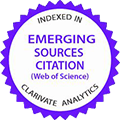Financial Policy and Firm’s Value: Pancasila Corporate Governance Disclosure as Moderating Variable
DOI:
https://doi.org/10.28992/ijsam.v7i2.794Keywords:
firm’s value, dividend policy, investment policy, financing policy, Pancasila corporate governance disclosure.Abstract
The impression of a company’s performance by an investor is known as firm value. The growth in the stock price of a corporation indicates good performance. The company’s ability to prosper its shareholders is demonstrated by the increase in its share price. Many factors influence the company’s worth, including both internal and external issues. The objectives of this study are to investigate 1) the impact of financial policy on firm value (FV) and 2) the moderated impact of Pancasila Corporate Governance Disclosure (PCGD) on the relationship between financial policy to FV. The dividend payout ratio (DPR), investment opportunity set (IOS), and debt-to-equity ratio (DER) are all indicators of financial policy. The sample size is 66 companies listed on the Indonesia Stock Exchange (IDX) over a 10-year period. Moderating Regression Analysis is used in this study. The results revealed that DPR and DER have a significant effect on FV; however, IOS has no such effect. PCGD has the ability to control the relationship between DPR and DER to FV, but not the relationship between IOS and FV.

